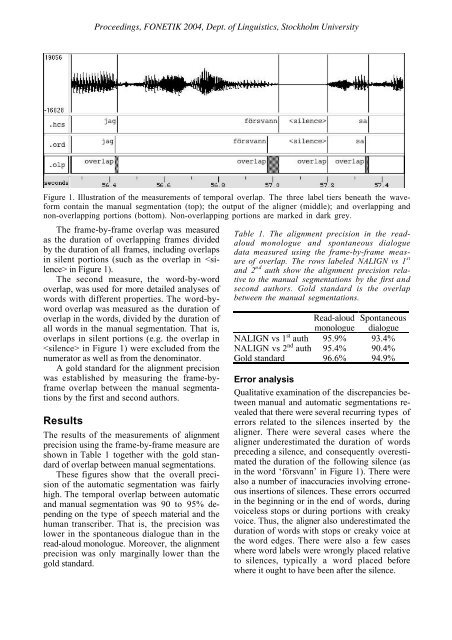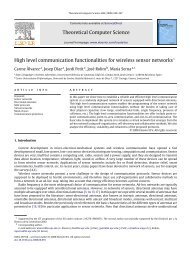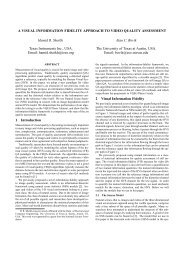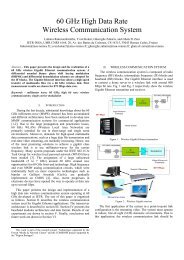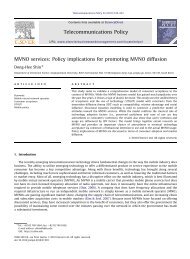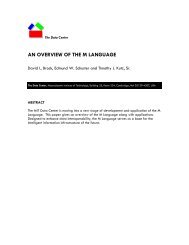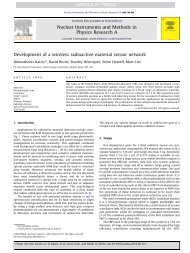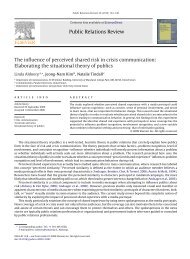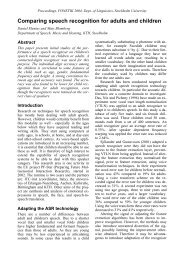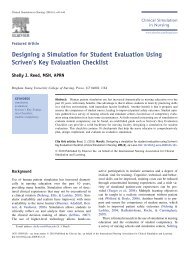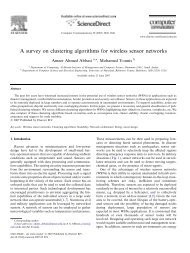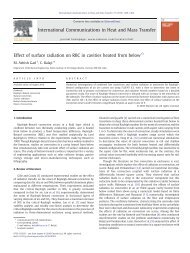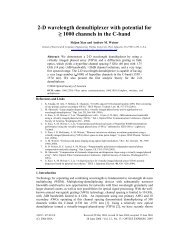Word level precision of the NALIGN automatic segmen- tation ...
Word level precision of the NALIGN automatic segmen- tation ...
Word level precision of the NALIGN automatic segmen- tation ...
You also want an ePaper? Increase the reach of your titles
YUMPU automatically turns print PDFs into web optimized ePapers that Google loves.
Proceedings, FONETIK 2004, Dept. <strong>of</strong> Linguistics, Stockholm University<br />
Figure 1. Illustration <strong>of</strong> <strong>the</strong> measurements <strong>of</strong> temporal overlap. The three label tiers beneath <strong>the</strong> waveform<br />
contain <strong>the</strong> manual <strong>segmen</strong><strong>tation</strong> (top); <strong>the</strong> output <strong>of</strong> <strong>the</strong> aligner (middle); and overlapping and<br />
non-overlapping portions (bottom). Non-overlapping portions are marked in dark grey.<br />
The frame-by-frame overlap was measured<br />
as <strong>the</strong> duration <strong>of</strong> overlapping frames divided<br />
by <strong>the</strong> duration <strong>of</strong> all frames, including overlaps<br />
in silent portions (such as <strong>the</strong> overlap in <br />
in Figure 1).<br />
The second measure, <strong>the</strong> word-by-word<br />
overlap, was used for more detailed analyses <strong>of</strong><br />
words with different properties. The word-byword<br />
overlap was measured as <strong>the</strong> duration <strong>of</strong><br />
overlap in <strong>the</strong> words, divided by <strong>the</strong> duration <strong>of</strong><br />
all words in <strong>the</strong> manual <strong>segmen</strong><strong>tation</strong>. That is,<br />
overlaps in silent portions (e.g. <strong>the</strong> overlap in<br />
in Figure 1) were excluded from <strong>the</strong><br />
numerator as well as from <strong>the</strong> denominator.<br />
A gold standard for <strong>the</strong> alignment <strong>precision</strong><br />
was established by measuring <strong>the</strong> frame-byframe<br />
overlap between <strong>the</strong> manual <strong>segmen</strong><strong>tation</strong>s<br />
by <strong>the</strong> first and second authors.<br />
Results<br />
The results <strong>of</strong> <strong>the</strong> measurements <strong>of</strong> alignment<br />
<strong>precision</strong> using <strong>the</strong> frame-by-frame measure are<br />
shown in Table 1 toge<strong>the</strong>r with <strong>the</strong> gold standard<br />
<strong>of</strong> overlap between manual <strong>segmen</strong><strong>tation</strong>s.<br />
These figures show that <strong>the</strong> overall <strong>precision</strong><br />
<strong>of</strong> <strong>the</strong> <strong>automatic</strong> <strong>segmen</strong><strong>tation</strong> was fairly<br />
high. The temporal overlap between <strong>automatic</strong><br />
and manual <strong>segmen</strong><strong>tation</strong> was 90 to 95% depending<br />
on <strong>the</strong> type <strong>of</strong> speech material and <strong>the</strong><br />
human transcriber. That is, <strong>the</strong> <strong>precision</strong> was<br />
lower in <strong>the</strong> spontaneous dialogue than in <strong>the</strong><br />
read-aloud monologue. Moreover, <strong>the</strong> alignment<br />
<strong>precision</strong> was only marginally lower than <strong>the</strong><br />
gold standard.<br />
Table 1. The alignment <strong>precision</strong> in <strong>the</strong> readaloud<br />
monologue and spontaneous dialogue<br />
data measured using <strong>the</strong> frame-by-frame measure<br />
<strong>of</strong> overlap. The rows labeled <strong>NALIGN</strong> vs 1 st<br />
and 2 nd auth show <strong>the</strong> alignment <strong>precision</strong> relative<br />
to <strong>the</strong> manual <strong>segmen</strong><strong>tation</strong>s by <strong>the</strong> first and<br />
second authors. Gold standard is <strong>the</strong> overlap<br />
between <strong>the</strong> manual <strong>segmen</strong><strong>tation</strong>s.<br />
Read-aloud Spontaneous<br />
monologue dialogue<br />
<strong>NALIGN</strong> vs 1 st auth 95.9% 93.4%<br />
<strong>NALIGN</strong> vs 2 nd auth 95.4% 90.4%<br />
Gold standard 96.6% 94.9%<br />
Error analysis<br />
Qualitative examination <strong>of</strong> <strong>the</strong> discrepancies between<br />
manual and <strong>automatic</strong> <strong>segmen</strong><strong>tation</strong>s revealed<br />
that <strong>the</strong>re were several recurring types <strong>of</strong><br />
errors related to <strong>the</strong> silences inserted by <strong>the</strong><br />
aligner. There were several cases where <strong>the</strong><br />
aligner underestimated <strong>the</strong> duration <strong>of</strong> words<br />
preceding a silence, and consequently overestimated<br />
<strong>the</strong> duration <strong>of</strong> <strong>the</strong> following silence (as<br />
in <strong>the</strong> word ‘försvann’ in Figure 1). There were<br />
also a number <strong>of</strong> inaccuracies involving erroneous<br />
insertions <strong>of</strong> silences. These errors occurred<br />
in <strong>the</strong> beginning or in <strong>the</strong> end <strong>of</strong> words, during<br />
voiceless stops or during portions with creaky<br />
voice. Thus, <strong>the</strong> aligner also underestimated <strong>the</strong><br />
duration <strong>of</strong> words with stops or creaky voice at<br />
<strong>the</strong> word edges. There were also a few cases<br />
where word labels were wrongly placed relative<br />
to silences, typically a word placed before<br />
where it ought to have been after <strong>the</strong> silence.


